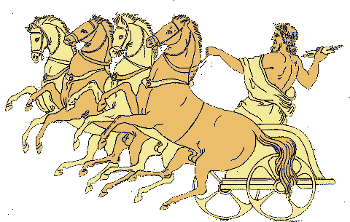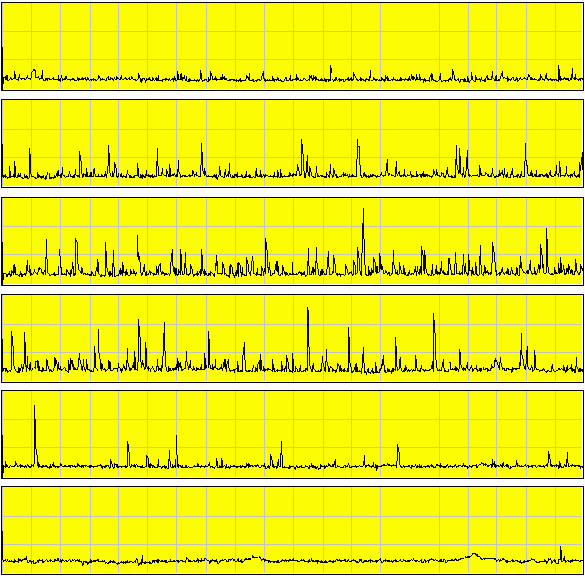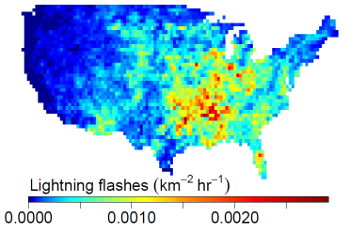Climate Change and Lightning
November 26, 2014
Zeus, the
king of the
Greek gods, sometimes exercised his power by throwing
lightning bolts. Devastating
earthquakes being uncommon in most areas,
lightning is the most powerful
force of nature most people have felt. There's the
light, the loud
thunderclap, and the resulting damage of
trees toppled and things set on
Fire. People are sometimes struck by lightning, but only 10% of those are killed.

Zeus, in his chariot, flinging lightning bolts.
An illustration in "Stories from the Greek Tragedians," by Alfred John Church (Dodd, Mead and Company, 1879).
(From Project Gutenberg, via Wikimedia Commons.)
According to the
US National Oceanic and Atmospheric Administration, the
odds of a person being struck by lightning in their lifetime is just
one in 12,000. Still, it isn't a good idea to be
golfing in a
thunderstorm. Also, wouldn't an
umbrella serve as a
lightning rod? I wrote about the
science of lightning rods in two previous articles,
Laser Lightning Rod, March 23, 2012 and
Our Technologist Forefathers, July 3, 2012.
Quite a few years ago, when my
daughter was in
high school, she was looking for a topic for a
science fair project. I had remembered a short article written in an
amateur astronomy magazine about using
FM radio transmissions to detect
meteors, so she decided to try this, with
good results. The principle behind such observations is that a meteor will generate a short-lived
plasma in the
atmosphere, and this plasma will
reflect radio waves from a distant
broadcasting station.
Her meteor detection
receiver was also a very good detector of
lightning, since it responded to the
amplitude of radio signals. Lightning generates
radio frequency interference, and anyone can hear this by listening to an
AM radio station during a lightning storm. The following figure shows the radio frequency intensity at 97.7
MHz during a particularly intense
thunderstorm in our area on June 12, 2003. You can see how the storm builds, and then decays, over a span of about two
hours.

Radio interference from a thunderstorm. Each data strip is fifteen minutes long, with interleaving fifteen minute intervals removed so the entire storm could be pictured. The data start at 9:00 AM on June 12, 2003, and continue through 11:45 AM. From the FM Radio Detection of Meteors Web Site)
As have many others, I've had
flights delayed by a
rule that
aircraft can't be
fueled at a time of an impending thunderstorm. These waits might become more frequent in the future, as
scientists have found that
global warming will lead to more lightning.[1-8] This research is reported in the
journal,
Science,[1] which the
British website,
The Register, calls a "major
boffinry mag."[7] It makes me wish I had published an article in Science.
There are about 20 million lightning strikes per
year in the US; and, worldwide, there are 8 million per
day, and a hundred each
second.[1,4] As everyone has noticed, lightning storms are much more frequent in the warmer
summer months than in colder
weather. A recent study by scientists from the
University of California, Berkeley,
Lawrence Berkeley National Laboratory (Berkeley, California), and the
State University of New York at Albany (Albany, New York) investigated the possible affect that global warming might have on lightning. The study was led by
David Romps, an
assistant professor at Berkeley.[2]
Romps and
graduate student,
Jacob Seeley, had the
hypothesis that
precipitation and
cloud buoyancy might be a
predictors of lightning, so they examined data for the year
2011 looking for a
correlation.[2] Precipitation, of course, is the indicator of a storm in progress, and cloud buoyancy is a measure of how
electric charge would separate in a cloud, a condition that leads to lightning. The ascent
speed of
convective clouds, the cloud buoyancy, is determined by the
convective available potential energy (CAPE), a factor that's measured by
radiosondes twice each day in the
United States.[2] Says Romp,
“Lightning is caused by charge separation within clouds, and to maximize charge separation, you have to loft more water vapor and heavy ice particles into the atmosphere... We already know that the faster the updrafts, the more lightning, and the more precipitation, the more lightning.”[2]
This research was enabled by the exquisite lightning dataset from the
National Lightning Detection Network based at State University of New York at Albany. This network records the time and location of each of the approximately 20 million flashes of cloud-to-ground lightning that occur in the United States.[4] It was found that the product of CAPE and precipitation explains lightning frequency with 77%
certainty for the
contiguous United States.[1-2] Says Romps, “We were blown away by how incredibly well that worked to predict lightning strikes."[2]
The research team then combined this information with the predictions of eleven
climate models that predict both changes in precipitation and CAPE through the end of this
century.[4] The models predicted, on average, an eleven percent increase per
degree Celsius in CAPE for the US. Combining this with the predicted increase in precipitation gave a 12 ± 5% increase in cloud-to-ground lightning strikes per degree Celsius. Since the models predict a 4°C (9°F) increase in global
temperature by century's end, this amounts to a 50% increase in lightning strikes.[1-7] Says Romps,
“With warming, thunderstorms become more explosive... This has to do with water vapor, which is the fuel for explosive deep convection in the atmosphere. Warming causes there to be more water vapor in the atmosphere, and if you have more fuel lying around, when you get ignition, it can go big time.”[2]

The intensity of lightning flashes, averaged over the year 2011, in the contiguous United States. Data from the National Lightning Detection Network.
(Via University of California Berkeley.)[2)]
An increased number of lightning strikes has quite a few consequences. Aside from the likelihood of additional human
injuries and
fatalities, there will be
wildfires and more
nitrogen oxides in the atmosphere. Lightning is the mechanism responsible for nitrogen oxides in the middle and upper
troposphere, and nitrogen oxides are
greenhouse gases that contribute to global warming.[1-6] The additional number of human casualties from these excess lightning strikes is small, since the present number is small.[7]
The actual mechanism of why CAPE increases with temperature is not known, but it's suspected that the
physics of
water is involved. The maximum
concentration of water in air increases
exponentially with temperature.[1-6] Romps also had the cautionary note that a temperature increase of 4 ° C by century's end would entail more problems than increased lightning.[3] This research was supported by the
U.S. Department of Energy, and the
National Science Foundation.[2]
References:
- David M. Romps, Jacob T. Seeley, David Vollaro, and John Molinari, "Projected increase in lightning strikes in the United States due to global warming," Science, vol. 346, no. 6211 (November 14, 2014), pp. 851-854, DOI: 10.1126/science.1259100.
- Robert Sanders, "Lightning expected to increase by 50 percent with global warming," University of California-Berkeley Press Release, November 13, 2014.
- Victoria Gill, "Climate change 'will make lightning strike more'," BBC News, November 13, 2014.
- Andrea Thompson and Climate Central, "Lightning May Increase with Global Warming," Scientific American, November 13, 2014.
- Forecasters: Warming Climate May Fuel More Lightning, Voice of America, November 13, 2014.
- Will Dunham, "Will a warmer climate mean more lightning? Yes, say scientists, Christian Science Monitor, November 13, 2014.
- Lewis Page, "Climate change will HUGELY increase chances of being HIT BY LIGHTNING To, er, 0.000002. Maybe. Long after you're dead," The Register (UK), November 14, 2014.
- Lightning strikes across the United States in August and September of 2011, YouTube Video, November 12, 2014. Data from the National Lightning Detection Network of the State University of New York at Albany, animated by David Romps, UC Berkeley, and Phil Ebiner, UC Berkeley Public Affairs.
- World Wide Lightning Location Network.
Permanent Link to this article
Linked Keywords: Zeus; king; Ancient Greece; Greek; Greek mythological figure; god; thunderbolt; lightning bolt; earthquake; lightning; natural phenomenon; force of nature; light; thunderclap; tree; fire; chariot; Project Gutenberg; Wikimedia Commons; US National Oceanic and Atmospheric Administration; odds; golf; golfing; thunderstorm; umbrella; lightning rod; science; daughter; high school; science fair; amateur astronomy; magazine; FM broadcasting; FM radio; transmission; meteorite; meteor; plasma; atmosphere; reflection; radio waves; broadcasting station; receiver; lightning; amplitude; electromagnetic interference; radio frequency interference; AM broadcasting; AM radio station; hertz; MHz; thunderstorm; hour; electromagnetic interference; radio interference; FM Radio Detection of Meteors; airline; flight; Federal Aviation Administration; rule; aircraft; aviation fuel; scientist; global warming; scientific journal; Science; Britain; British; The Register">The Register; boffin; boffinry; year; day; second; summer; weather; University of California, Berkeley; Lawrence Berkeley National Laboratory (Berkeley, California); State University of New York at Albany (Albany, New York); David Romps; assistant professor; postgraduate education; graduate student; Jacob Seeley; hypothesis; precipitation; cloud; buoyancy; prediction; predictor; 2011; correlation; electric charge; speed; atmospheric convection; convective; convective available potential energy (CAPE); radiosonde; United States; water vapor; ice; vertical draft; updraft; National Lightning Detection Network; certainty; contiguous United States; climate model; century; degree Celsius; temperature; injury; death; fatality; wildfire; nitrogen oxide; troposphere; greenhouse gas; physics; water; concentration; exponential function; United States Department of Energy; National Science Foundation.